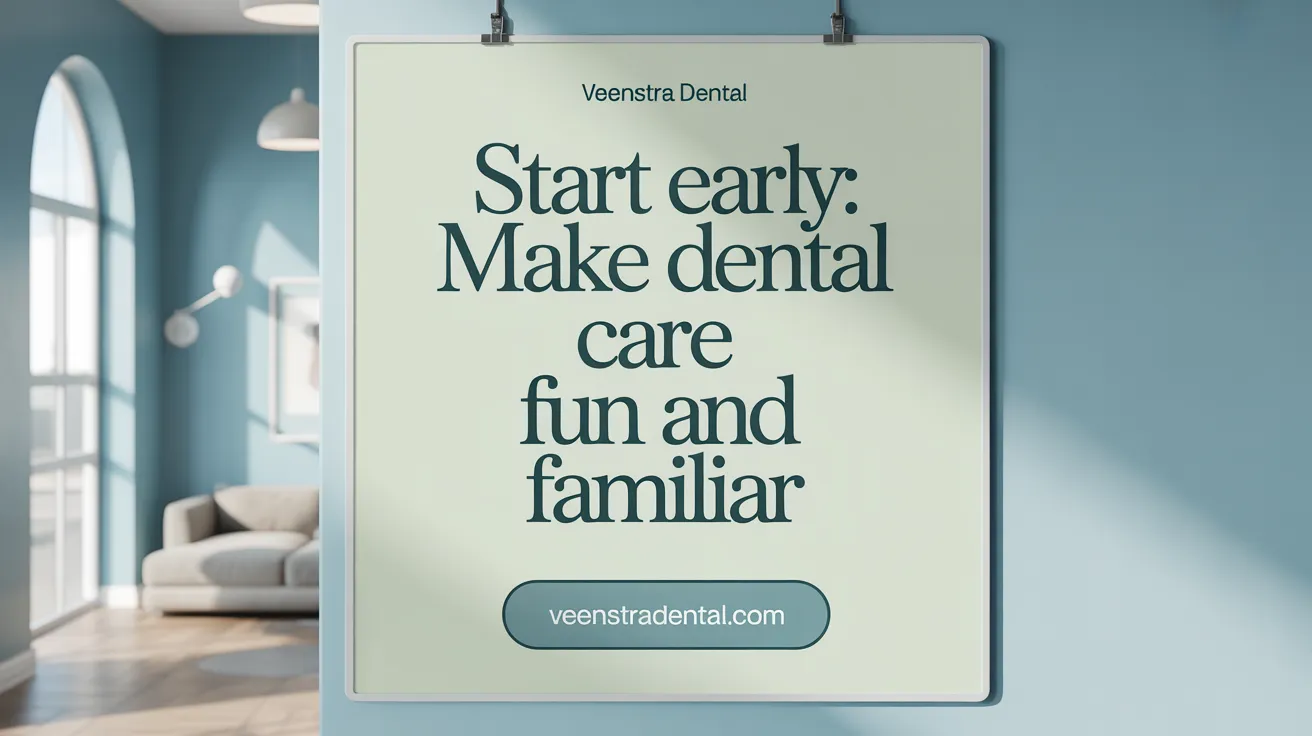Welcome to Stress-Free Smiles
Dental visits can be a source of stress and anxiety for many children. However, with thoughtful strategies, preparation, and a supportive dental environment, parents and dental professionals can transform these experiences into positive, even enjoyable moments. This article explores how to help children develop a love for their dental visits, build trust, and cultivate lifelong good oral health habits through proven methods and practical advice.
Early Preparation and Positive Introduction to Dental Care

Starting oral hygiene at infancy
Establishing an early oral hygiene routine is vital from the moment a child's first teeth erupt. Parents should begin by gently wiping infants' gums with a soft, damp cloth, which helps set a foundation for future oral care habits. As teeth appear, introducing a small, soft-bristled toothbrush with fluoride toothpaste—and supervising tooth brushing—is recommended until the child can do it independently around age 7 or 8. This early start not only promotes healthy teeth but also familiarizes children with the routine, reducing fear in later years (Pediatric Dental Care: Essential Tips for Parents, Oral Health Tips for Children, Early Dental Care - Tips for Parents).
First dental visit timing and purpose
The American Academy of Pediatric Dentistry recommends scheduling the child's first dental visit by their first birthday or within six months of the first tooth's eruption. The initial visit primarily aims to familiarize children with the dental environment, assess early development, and provide guidance on maintaining oral health at home. Regular check-ups every six months help detect problems early and reinforce positive attitudes towards dental care (A Child's First Dental Visit - Fact Sheet, Early Dental Visits Reduce Fear, Early Dental Care Introduction).
Role of parents in early dental awareness
Parents play a crucial role in shaping their child's perceptions of dental visits. By modeling good oral hygiene practices, speaking positively about dental health, and supporting their child emotionally, parents help create a trusting and relaxed environment. Early conversations about dental care, reinforced with stories or videos, make the experience more approachable. Involving children in selecting toothbrushes, or role-playing dental visits at home, fosters a sense of control and curiosity (Parent's Role in Children's Dental Health, Role-Playing and Storytelling for Dental Care, Get Children Excited About Dental Care).
Use of storytelling, videos, and role-play
Utilizing age-appropriate storytelling, colorful videos, and pretend play helps demystify dental procedures. These tools can turn what might seem intimidating into fun and engaging activities. For example, reading books about visiting the dentist or acting out a dental appointment using toys allows children to become familiar with the process, reducing anxiety and building confidence (Making Dental Visits Fun and Fear-Free for Your Child, Role-Playing Dental Visits at Home, Play and Positive Communication).
Familiarizing children with dental environment pre-visit
Before formal appointments, parents and dental professionals can help children get comfortable by touring the dental office, introducing staff members, and showing the dental tools in a friendly manner. Some offices provide tours or videos that simulate what the visit will be like. Bringing along a favorite toy or blanket, and explaining that the dental team is friendly and gentle, further eases nervous feelings. These steps promote trust and help establish a positive outlook on oral health care, laying the groundwork for stress-free and successful dental visits (Reducing Dental Anxiety in Children, Strategies for Easing Dental Fear, Creating a Welcoming Dental Environment).
Creating a Child-Friendly and Comforting Dental Environment
 A child-friendly and comforting dental environment is characterized by bright, colorful decor featuring cartoon designs, playful themes, and welcoming visuals that immediately put children at ease. These colorful interior details serve not only to make the space inviting but also to distract young patients, helping to reduce fear and anxiety (Pediatric dentistry for children, Creating a positive dental experience for your child).
A child-friendly and comforting dental environment is characterized by bright, colorful decor featuring cartoon designs, playful themes, and welcoming visuals that immediately put children at ease. These colorful interior details serve not only to make the space inviting but also to distract young patients, helping to reduce fear and anxiety (Pediatric dentistry for children, Creating a positive dental experience for your child).
Incorporating toys, books, and interactive play areas within the office creates opportunities for children to engage and feel secure. Waiting rooms often have puzzles, plush toys, and engaging activities that make the experience enjoyable even before the appointment begins (Creating a positive dental environment for kids, Engaging waiting room toys).
Distraction techniques such as ceiling-mounted TVs, tablets, or headphones playing cartoons or educational videos help redirect the child's attention during procedures, minimizing discomfort and increasing cooperation. These methods are especially effective in helping children remain calm and relaxed during treatment (Distraction techniques during dental treatment, Distraction techniques in dentistry).
Trained, gentle dental staff plays a crucial role in creating a positive atmosphere. These professionals use friendly, age-appropriate language, gentle touches, and positive reinforcement to foster trust. Staff trained in pediatric care are skilled at explaining procedures in simple terms and involving parents in the process, which builds confidence and comfort (Staff trained in pediatric dentistry, Using child-friendly language in dentistry).
Parental presence and comfort items like stuffed animals, blankets, or favorite toys provide additional reassurance. Allowing children to bring these items into the dental room helps them feel more secure and in control (Bringing comfort items to the dentist, Comfort items for dental visits).
Overall, the ideal child-friendly dental office combines engaging decor, distraction techniques, empathetic staff, and a safe, secure environment. This approach not only eases fears but also sets the stage for positive lifelong dental habits (Building positive relationships with dentists, Creating a positive dental experience for children).
Techniques to Reduce Dental Anxiety and Build Trust

What techniques can reduce children's dental anxiety and fear?
Several practical strategies can help ease children's fears during dental visits. Utilizing distraction methods—such as toys, videos, or music—keeps children’s attention away from procedures, making the experience less stressful. Employing a gentle, positive tone with age-appropriate language reassures children and builds trust. Clear, honest explanations using visual aids like pictures or models help children understand what to expect, reducing uncertainty. Creating a welcoming, colorful environment with friendly staff and appropriate-sized tools further lessens sensory overload and discomfort (child-friendly dental environment).
Early and regular dental visits are vital; familiar experiences foster comfort and decrease fear over time (early dental visits). Reinforcing positive behaviors with praise and rewards (positive reinforcement in pediatric dentistry), and involving parents to model good oral hygiene habits and calm demeanor (parents' positive attitude toward dental visits), also contribute significantly to building confidence.
Overall, combining these approaches creates a supportive atmosphere that can turn a potentially anxiety-inducing experience into a positive step toward lifelong oral health (creating a positive dental experience for your child).
What methods build trust and reassurance to foster positive attitudes toward dental visits in children?
Building a foundation of trust is essential for encouraging positive perceptions of dental care. Creating a child-friendly environment with cheerful decor, engaging visual aids, and appropriately sized dental equipment helps children feel safe from the outset. Consistent, empathetic communication—explaining procedures in simple, positive language (using positive language about dental procedures)—further reassures young patients.
Pre-visit preparation techniques like storybooks, videos, or role-playing at home familiarize children with dental tools and routines, diminishing the fear of the unknown. Allowing children to choose comfort items such as stuffed animals or blankets provides additional reassurance (bringing comfort items to dental visits).
Parental involvement plays a crucial role; calm, supportive parents who maintain a positive attitude and model good dental habits help children feel secure (parents modeling good dental hygiene habits). Reinforcement through praise after successful visits encourages a positive association with dental care (reward systems for kids at the dentist).
Additionally, phased introductions—starting with brief, non-invasive visits—allow children to gradually adapt, fostering trust and confidence that can last a lifetime (scheduling short dental visits).
Encouraging Cooperation Through Positive Reinforcement

What is positive reinforcement and why is it important?
Positive reinforcement involves providing praise, rewards, or encouragement to children to foster desirable behaviors. In pediatric dentistry, it plays a vital role in encouraging children to cooperate during exams and treatments. By recognizing their efforts and achievements, children associate dental visits with positive feelings, making future visits less stressful. Learn more about Positive reinforcement in pediatric dentistry.
How does praise, rewards, and verbal encouragement help?
Using words of praise and small rewards like stickers or toys can motivate children to behave well. Verbal encouragement, such as saying “You’re doing a great job!” or “That was brave of you!” boosts their confidence and helps them feel proud. For tips on Using positive reinforcement to reduce dental anxiety, see this guide.
Should rewards be tailored to each child?
Yes. Rewards are most effective when they match each child's interests. Some children may love stickers, while others prefer small toys or stationery. Tailoring rewards ensures they find the incentive meaningful, which increases motivation and cooperation. Research on Children's motivation and range of rewards provides more details.
Why is giving children a choice important?
Allowing children to select their own rewards makes the experience more engaging. When children choose, they feel a sense of control, which can reduce fear and resistance. This strategy also helps them learn decision-making skills and builds positive associations with dental visits. Explore Encouraging choice and engagement in dental visits for ideas.
How does positive reinforcement impact cooperation and anxiety?
Consistently applying positive reinforcement creates a trusting relationship between the child and the dental provider. It encourages cooperation, as children associate good behavior with positive outcomes. Moreover, it helps reduce anxiety because the experience becomes associated with rewards and praise rather than fear. See Managing dental anxiety in children for strategies.
What roles do parents and dental staff play?
Parents and dental staff are crucial in delivering effective reinforcement. Parents should model positive attitudes and praise their children at home, setting a foundation for cooperation. Dental staff should be trained to recognize progress, offer genuine praise, and give appropriate rewards, creating an environment that supports positive behavior development. More on Parental support and positive reinforcement and Creating a welcoming dental environment.
Practical Tips for Parents to Facilitate Stress-Free Dental Visits
 Supporting children in having relaxed and positive dental appointments involves several thoughtful strategies. First, scheduling visits at times when children are naturally alert and not hungry helps them feel more comfortable during the appointment. Starting dental visits early—preferably by their first birthday—familiarizes children with the environment and reduces fear through routine (Early Dental Visits for Children, First Dental Visit by First Birthday). Preparing your child in advance by explaining what will happen in simple, positive language, and using creative methods like role-playing or demonstrations, can demystify the experience (Role-Playing and Storytelling for Children, Using Demonstrations to Ease Children's Fear). Choosing a pediatric dentist who specializes in child-friendly care and creating a cheerful, colorful office environment with toys and engaging decor are essential for making visits inviting (Choosing a Pediatric Dentist, Creating a Welcoming Dental Environment).
Supporting children in having relaxed and positive dental appointments involves several thoughtful strategies. First, scheduling visits at times when children are naturally alert and not hungry helps them feel more comfortable during the appointment. Starting dental visits early—preferably by their first birthday—familiarizes children with the environment and reduces fear through routine (Early Dental Visits for Children, First Dental Visit by First Birthday). Preparing your child in advance by explaining what will happen in simple, positive language, and using creative methods like role-playing or demonstrations, can demystify the experience (Role-Playing and Storytelling for Children, Using Demonstrations to Ease Children's Fear). Choosing a pediatric dentist who specializes in child-friendly care and creating a cheerful, colorful office environment with toys and engaging decor are essential for making visits inviting (Choosing a Pediatric Dentist, Creating a Welcoming Dental Environment).
During the appointment, maintaining a calm and enthusiastic attitude reassures children that dental visits are safe and fun (Parents' Positive Attitude Toward Dental Visits, Parents Modeling Calm Behavior). Bringing comfort items such as stuffed animals, blankets, or favorite toys provides emotional security and distraction (Comfort Items for Dental Visits, Bringing Comfort Items to the Dentist). Employing distraction techniques like toys, games, or educational videos can divert their attention from any discomfort (Distraction Techniques During Dental Procedures, Using Toys and Games at the Dentist). Using positive reinforcement through praise or small rewards after the visit encourages cooperation and builds a sense of achievement (Positive Reinforcement in Pediatric Dentistry, Reward Systems for Kids at the Dentist).
Engaging children in oral health education and including them in decision-making about their dental care can foster a sense of control and reduce anxiety (Children’s Oral Hygiene Education, Involving Children in Dental Care Choices). Celebrating milestones, such as their first visit or bravery during procedures, with stickers or small treats reinforces positive feelings about dental health (Celebrating Dental Milestones, Encouraging Children’s Bravery at the Dentist). Working closely with your pediatric dental team and communicating any concerns helps tailor the experience to your child's needs, ensuring each visit contributes to a trusting and stress-free relationship with dental care (Parental Support and Positive Reinforcement, Communication Between Dentist, Parent, and Child).
Fostering Lifelong Smiles
Transforming children’s dental visits from fearful experiences into positive, engaging moments requires preparation, empathy, and collaboration between parents, dental professionals, and children themselves. Early introduction to dental care, a welcoming and fun environment, gentle communication, and effective anxiety-reducing techniques build trust and cooperation. Positive reinforcement and treating visits as enjoyable milestones encourage children to embrace dental health as a natural and rewarding part of life. With these strategies, parents can help their children develop confidence and enthusiasm for dental visits, setting the foundation for a lifetime of healthy smiles.
